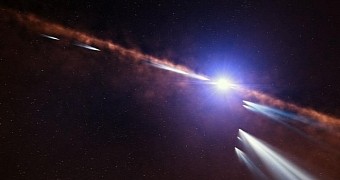A relatively young star located not too far from us is orbited by hundreds of comets, astronomers write in a paper published in the journal Nature this October 23.
This means that, when compared to other stars researchers have until now had the chance to study, this one has no choice but cope with some seriously intense comet traffic.
The star in question, featured in the image accompanying this article, sits at a distance of about 63 light-years from our Sun. It is estimated to have formed some 20 million years ago, which makes it quite young.
The celestial body's official name is Beta Pictoris. As detailed by astronomers, it's nearly 2 times more massive than the Sun, and almost 9 times more luminous.
Documenting comet traffic around a star
In their paper in the journal Nature, the European Southern Observatory researchers behind this investigation explain that astronomers first became aware of heavy comet traffic around Beta Pictoris about 3 decades ago.
What drew their attention were subtle changes in the light leaving this star and heading our way. Eventually, they figured out that these cosmic hiccups were caused by comets orbiting the star.
Despite being mindbogglingly small when compared to Beta Pictoris, the comets orbiting this star are still big enough to produce gigantic Tails made up of gas and dust. It is these tails that block some of the light originating from Beta Pictoris.
Hoping to gain a better understanding of the comet traffic around this nearby star, astronomers turned to compiling and analyzing information provided by the HARPS instrument at the European Southern Observatory's La Silla Observatory in Chile.
All in all, the researchers had a close look at about 1,000 observations made between the years 2003 and 2011. Data obtained in this manner made it possible for them to put together the most complete census of comets around a star to have until now been created.
Two different types of comets are orbiting this star
Beta Pictoris is now said to be orbited by nearly 500 comets. Of these, some have been around for eons and have already made several passages near the star. Others seem to have only recently formed in the aftermath of the breakup of considerably larger objects.
Interestingly enough, astronomers claim to have even been able to determine the exact orbits and the physics governing the movement of many of the comets now busy flying around Beta Pictoris.
“For the first time a statistical study has determined the physics and orbits for a large number of exocomets,” researcher Flavien Kiefer said in a statement.
To some people, studying comets orbiting a star might sound like a complete waste of time. Still, scientists say that this is by no means the case. On the contrary, such investigations can help shed new light on the formation and the evolution of our Solar System.
As Flavien Kiefer put it, “This work provides a remarkable look at the mechanisms that were at work in the Solar System just after its formation 4.5 billion years ago.”

 14 DAY TRIAL //
14 DAY TRIAL //